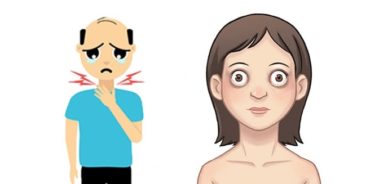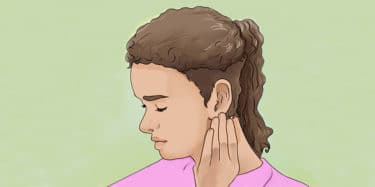A goiter is an enlarged thyroid gland that causes the neck to swell above normal. It is one of the most common thyroid disorders. Goiters are often harmless but symptoms can occur, and treatment may be required depending on the size and type of goiter. Although goiters are usually painless, a large goiter can cause a cough and make it difficult for you to swallow or breathe. The most common cause of goiters worldwide is a lack of iodine in the diet. Goiter is a treatable disease and treatment depends on size of the goiter, your symptoms and underlying cause.
Table of Contents
What is goiter?
The thyroid is a butterfly-shaped gland in your neck under the Adam’s apple. It secretes hormones that help regulate bodily functions, including metabolism. It also regulates heart rate, respiration, digestion and mood. If your thyroid gland grows above normal, it is called goiter. Goiter may develop in any human, but it has been observed that it is more common in women.
Goiter may heal spontaneously without the need for treatment, or it may be another symptom of a possible serious thyroid disorder that requires medical attention. This discomfort sometimes affects the function of the thyroid gland and may make the patient’s life difficult. Although goiter is usually a painless disease, sometimes it can cause coughing, difficulty in swallowing and shortness of breath.
The most common cause of goiter worldwide is iodine deficiency in nutrition. However, in iodized salt-consumed areas, a goiter is more often due to the over- or underproduction of thyroid hormones or to nodules that develop in the gland itself.
Symptoms of goiter
- Most commonly, the swelling of the anterior neck
- Difficulty in breathing or swallowing
- Aphonia and hoarseness
- coughing
- Dizziness when the arm is raised
- Feeling node in the throat

Causes of goiter
Iodine deficiency
The main cause of goiter disease is iodine deficiency in the body. In order for the thyroid gland to produce thyroid hormone, the body should be able to receive enough iodine. In case of iodine deficiency, thyroid does extra work and thyroid gland grows more than it should. In the developing world, people who live inland or non-castal elevated areas are often iodine deficient and can develop goiter when the thyroid enlarges in an effort to obtain more iodine.
Graves’ disease (Toxic goiter)
A goiter can sometimes occur when your thyroid gland produces too much thyroid hormone (hyperthyroidism). In Graves’ disease, antibodies produced by your immune system mistakenly attack your thyroid gland, causing it to produce excess thyroxine. This overstimulation causes the thyroid to swell. The most common symptoms are eye enlargement and increased thyroid hormone in the blood.
Hashimoto’s disease
Hashimoto’s disease is another important cause of goiter which caused by the inability of the thyroid gland to produce enough thyroid hormones due to inflammation. The pituitary gland begins to produce high amounts of THS (thyroid stimulating hormone) as it senses the low hormone level. As a result, the thyroid swells. The most common symptoms are weight gain, dryness in the skin, fatigue, chills, cramps, voice changes and constipation.
Thyroid nodules
Solid or liquid cysts (nodules) may cause swelling of the thyroid gland. These nodules usually have no connection to cancer and are harmless to health. But they should be thoroughly investigated when they are detected. Solid and fluid-filled cysts in multinodular goiter are seen on both sides of the thyroid.
Thyroid Cancer
Thyroid cancer may affect thyroid hormone and trigger thyroid gland swelling. However, thyroid cancer is not a common cause. Thyroid nodule biopsy is used to diagnose thyroid cancer.
Pregnancy
Pregnancy may also cause swelling of the thyroid gland.
Inflammation
Pain and swelling are seen in the thyroid in case of inflammation. In this case, the hormone may be more or less secreted.
Risk factors in goiter
- Iodine deficiency: Those who do not pay enough attention to iodine consumption, who have difficulty in accessing to iodine, those who live in remote and non-coastal climates are at risk.
- Gender: Women compared to men have more tendency .
- Age: Although sometimes goiter can be seen in children, it is more common in women and men over 40 years of age.
- A number of medications used: especially cardiovascular medications and psychiatric medications can accelerate the development of goiter. People undergoing radiation therapy for the neck and chest are also at risk.
- Medical history of the patient: Familial susceptibility increases the likelihood of getting a guater. People with goiter in their family can get this disease easier.
- Menopause and pregnancy: The existence of a relationship between menopause, pregnancy and goiter is accepted in the scientific world, even if it is not proven.
Goiter types
Colloid goiter (Endemic)
This type of goiter caused by iodine deficiency is the result of the body’s inability to get enough iodine to produce thyroid hormone. These patients usually live in regions and countries where iodine deficiency has been observed.
Nontoxic goiter (sporadic)
This type of goiter is usually caused by lithium-containing drugs. There is no problem in the production of thyroid hormones in this disease. Lithium-containing drugs used in the treatment of psychological disorders such as bipolar disorder may cause nontoxic goiter. However, in some cases where the exact cause is unknown, they may cause non-toxic goiter.
Toxic or multinodular goiter
In this goiter nodule, one or more thyroid nodules may develop. In this case, thyroid nodules, ie, the tubers and masses found in the thyroid gland can produce hyperthyroidism by producing excessive thyroid hormone.
Internal, External and Toxic Goiter
The nodules (masses), which are apperantly noticeable in the neck region, are defined as external goiter, while the growth of the masses into the thoracic cavity is called the internal goiter. At same time, doctors can use term “toxic goiter” in order to state that the condition of goiter disease is advanced, that is, thyroid gland produces more than normal hormones.
Diagnosis of goiter
First of all your doctor does physical examination to evaluate the nodule in your neck to make a diagnosis. Then asks you to have the following tests:
- Blood test: The causes of increase in hormone levels and antibody production are investigated.
- Thyroid scan: During a thyroid scan, you’ll be injcted a radioactive isotope into the vein on your arm. The you will lie on a table with your head stretched backward while a special camera produces an image of your thyroid on a computer screen.
- Ultrasound: Sound waves bounce through your neck and back by a wand like device, forming images on a computer screen. The images reveal the size of your thyroid gland and whether the gland contains nodules.
- Biopsy: Small specimens are taken from the thyroid tissue with biopsy and these samples will be sent to the laboratory for examination.
Goiter treatment
Today, goiter is a disease that can be treated successfully, your doctor may suggest different treatment methods depending on the condition, size and symptoms of the disease.
Observation
If your goiter is small and does not cause problems and your thyroid gland works normally, your doctor may recommend a wait-and-see approach.
Treatment of goiter with medication
Especially when the patient has hyperthyroidism, it is prescribed medications to shrink the guater nodule. Mostly, levothyroxine drugs (Levoxyl, Tironsint, Synthroid) are used. In case of there is inflammation, the patient should be treated with aspirin, corticosteroids, etc. like medication eradicating inflammation.
Goiter surgery
If you have a large goiter that prevent breathing or swallowing, or if you have nodular goiter that causes hyperthyroidism, taking all or part of the thyroid gland (total or partial thyroidectomy) may give a positive result. Surgery is also the treatment for thyroid cancer. Depending on the amount of thyroid, you may need to use levothyroxine after surgery.
Treatment with Radioactive Iodine (RAI)
Radioactive iodine may be required in patients with toxic multinodular disease. In this case, the patient is given RAI. This drug, which is taken orally, goes to thyroid through blood and treats the destroyed thyroid tissue. As a result, size of goiter becomes smaller.
Goiter herbal treatment
The herbal treatment methods listed below may cause side effects especially in some patients who use medication. Thus, you should contact your doctor before using goiter herbal treatment methods. Otherwise, you may experience serious health problems.
Goitrogenic foods
Guatrogen nutrients are foods that reduce absorption of iodine in body, which may lead to the expansion of thyroid gland. Brussels sprouts, cabbage, soy products, cauliflower, radish, turnip, spinach, mustard, peach, strawberry and pear are guatrogenic foods. If you have goiter disease, consume these foods in limited amounts and take care not to take with guater medications.
Watercress
Watercress, a member of the crucifer family, may be preferred in the treatment of goiter. Crush the watercress, which is an excellent source of iodine then apply toughly the ready paste onto the area under the neck where it has a swelling. Wait for 20 minutes. You can benefit from this miraculous effect of watercress after applying it for 10 days. You can mix 2 tablespoons of watercress with half a glass of water. After 6 months of treatment, you can witness a serious improvement in your goiter.
Garlic
Garlic, which you can use during goiter treatment, reduces swelling in the neck and helps to secrete thyroid hormones in a healthier level. Chew 3-4 garlic cloves daily to make the most efficient use of garlic. You can benefit from the healing power of it by adding garlic to your meals.
Dandelion
Dandelion is a kind of herbaceous plant whose leaves can also be consumed as a salad, is also very effective in treatment of goiter. First take a 2/3 dandelion leaf and dip butter on one side. Then heat the dandelion-butter mixture. Fix this buttered leaf to your neck using a band or bandage. Wait for 1 hour in this way. Apply this for 2 weeks, 1-2 times a day.
Green tea
Drinking 2-3 cups of green tea during the day can contribute positively to your treatment. Green tea, an excellent source of antioxidants, contains natural fluoride, which makes the thyroid gland works healthily. To prepare green tea, put 1 teaspoon of green tea leaves into a cup of boiling water. Leave for brewing. After 5/10 minutes, you can drink your tea.
Lemon Balm
Another plant that is successful in the treatment of hyperthyroidism is goiter lemon balm which decreases thyroid stimulating hormone levels and treats goiter. Lemon balm, which is also rich in selenium, regulates thyroid function.
Sorrel leaves
The sorrel leaves which is a wonderful source of minerals like iodine etc. can be used in the treatment of goiter. Crush a handful of sorrel leaf. Then mix the paste with 2 tablespoons of olive oil. Finally, spread the paste around your neck. After waiting 30 minutes, rinse your neck with warm water. Apply this treatment 1 time a day until your swelling in your neck recovered.
Recommendations to goiter patients
- Because iodine deficiency is one of the most important causes of goiter, choose a nutritional program with plenty of iodine. You can consume plenty of iodised salt, eggs, shrimp, cow’s milk, cabbage, sea food, cod, natural yoghurt to eliminate your iodine deficiency. You can also eliminate the iodine deficiency of your body by consuming kelp, a type of algae that usually grows at the ocean shores. Kelp, which is rich in potassium, magnesium, iron and calcium, can prevent the overwork of thyroid.
Iodine overconsumption may also be the cause of , thus consult your doctor about this!
- Selenium deficiency may be behind the worsening of your thyroid discomfort. So shellfish, onions, tuna, oats, meat, poultry, sunflower seeds, barley, brown rice etc. You can contribute to the healing of your goiter by consuming foods rich in selenium.
- Limit guatrogenic food consumption as much as possible such as spinach, strawberry, broccoli, sweet potato, soybeans, cauliflower, turnip, cabbage, etc.
- Avoid processed food, alcohol, soy products, coffee, soda consumption
- Exercise regularly
- Use B vitamin complexes under the supervision of your doctor
- Use coconut oil in your meals.
- Once a day, drink a glass of barley juice.
- Use filtered water.
- Have massage therapy methods such as reflexology and acupuncture.
- Avoid heavy meals. Eat light foods as much as possible.




